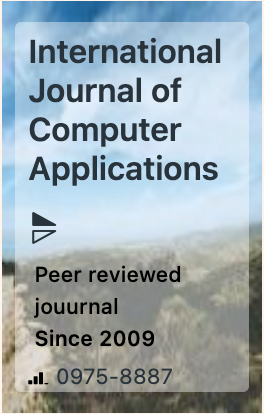The week's pick
Random Articles
Reseach Article
Evaluation of Rice Farmers' Acceptance of a Knowledge Management System using the Technology Acceptance Model
| International Journal of Computer Applications |
| Foundation of Computer Science (FCS), NY, USA |
| Volume 186 - Number 80 |
| Year of Publication: 2025 |
| Authors: George Essah Yaw Okai, Raphael Olufemi Akinyede, Millicent Agangiba, William Akotam Agangiba |
 10.5120/ijca2025924744
10.5120/ijca2025924744
|
George Essah Yaw Okai, Raphael Olufemi Akinyede, Millicent Agangiba, William Akotam Agangiba . Evaluation of Rice Farmers' Acceptance of a Knowledge Management System using the Technology Acceptance Model. International Journal of Computer Applications. 186, 80 ( Apr 2025), 45-53. DOI=10.5120/ijca2025924744
Abstract
This study evaluates the level of acceptance of a Knowledge Management System (KMS) designed to support intelligent rice farming practices, using the Technology Acceptance Model (TAM). Data from 315 rice farmers in Afere, Ghana, were analysed using Structural Equation Modelling (SEM) to determine how perceived usefulness (PU) and perceived ease of use (PEOU) influence attitudes toward use (ATU), behavioural intention to use (BIU), and actual system usage (ASU). The findings demonstrate that PEOU significantly impacts PU and ATU, which subsequently drive BIU and ASU. Findings indicate that enhancing usability and fostering positive user attitudes can significantly increase KMS adoption by rice farmers. This study provides valuable insights for improving the effectiveness and acceptance of technology-driven solutions in agricultural communities.
References
- Hajric, E. (2018), “Knowledge Management - system and Practices: A Theoretical and Practical Guide for Knowledge Management in Your Organization”, Jacksonville, Florida, USA, p. 211.
- Duan, Y., Yang, M., Huang, L., Chin, T., Fiano, F., Nuccio, E. de, and Zhou, L. (2022), “Unveiling the impacts of explicit vs. tacit knowledge hiding on innovation quality: The moderating role of knowledge flow within a firm”, Journal of Business Research, Vol. 139, pp. 1489–1500.
- Ragab, M. and Arisha, A. (2013), “Knowledge management and measurement: a critical review”, Journal of Knowledge Management Vol. 17, No. 6, pp. 873–901.
- Davis, F.D., Granić, A. and Marangunić, N., (2024), “The technology acceptance model: 30 years of TAM”. Springer International Publishing AG.
- Davis, F. (1989), “Perceived usefulness, perceived ease of use, and user acceptance of information technology”, MIS Quarterly Vol. 13, No. 3, pp. 319–340.
- Surendran, P., (2012), “Technology acceptance model: A survey of literature”, International Journal of Business and Social Research, Vol.2 No.4, pp.175-178.
- Taylor, S. and Todd, P., (1995), “ Assessing IT usage: The role of prior experience”, MIS quarterly, pp.561-570.
- Venkatesh, V. and Davis, F.D. (2000), “A theoretical extension of the technology acceptance model: Four longitudinal field studies”, Management Science, Vol. 46, No.2, pp.186-204.
- Chau, P.Y. and Hu, P.J., (2002), “Examining a model of information technology acceptance by individual professionals: An exploratory study”, Journal of Management Information Systems, Vol.18, No.4, pp.191-229.
- Pavlou, P.A., (2003), “Consumer acceptance of electronic commerce: Integrating trust and risk with the technology acceptance model”, International journal of electronic commerce, Vol.7, Vol.3, pp.101-134.
- Selim, H.M., (2003), “An empirical investigation of student acceptance of course websites”, Computers & Education, Vol.40, No.4, pp.343-360.
- Buabeng-Andoh, C. (2018), “Predicting students’ intention to adopt mobile learning: A combination of the theory of reasoned action and technology acceptance model”, Journal of Research in Innovative Teaching & Learning, Vol.11, No. 2, pp. 178-191.
- Sohn, K. and Kwon, O., (2020), “Technology acceptance theories and factors influencing artificial Intelligence-based intelligent products”, Telematics and Informatics, Vol.47, p.101324.
- Rad, D., Egerau, A., Roman, A., Dughi, T., Balas, E., Maier, R., Ignat, S. and Rad, G. (2022), “A Preliminary Investigation of the Technology Acceptance Model (TAM) in Early Childhood Education and Care”, BRAIN Broad Research in Artificial Intelligence and Neuroscience, Vol.13, No.1, pp.518-533.
- Bagozzi, R.P. (2007), “The legacy of the technology acceptance model and a proposal for a paradigm shift”, Journal of the Association for Information Systems, Vol.8, No.4, p.3.
- Zulkifli, N.S., Roslan, S.N.A. and Shafri, H.Z.M., (2024), “The Effect of Technology Acceptance Model (TAM) Challenges in Building Information Modelling (BIM) Implementation in Relation to Malaysian Government Mandate”, Journal of Advanced Research in Applied Sciences and Engineering Technology, Vol .40, Vol.2, pp.140-151.
- Dishaw, M.T. and Strong, D.M. (1999), “Extending the technology acceptance model with the task–technology fit constructs”, Information & Management, Vol.36, No.1, pp.9-21.
- Holden, H. and Rada, R., (2011), “Understanding the influence of perceived usability and technology self-efficacy on teachers’ technology acceptance”, Journal of Research on Technology in Education, Vol .43, No.4, pp.343-367.
- Legris, P., Ingham, J. and Collerette, P. (2003), “Why do people use information technology? A critical review of the technology acceptance model”, Information & Management, Vol.40, No.3, pp.191-204.
- Saidu, A., Clarkson, A., Adamu, S., Mohammed, M., and Jibo, I. (2017), “Application of ICT in agriculture: Opportunities and challenges in developing countries”, International Journal of Computer Science and Mathematical Theory , Vol. 3, No. 1, pp. 8–18.
- Ray, A. (2017), “Knowledge management in agriculture and its methods: A study”, International Journal of Next Generation Library and Technologies, Vol. 3, No. 2, pp. 1– 8.Jennex, M. (2020), “Towards understanding and implementing knowledge management strategy”, Current Issues and Trends in Knowledge Management, Discovery, and Transfer, IGI Global, pp. 103–125.
- Thakkar, J. (2020), Structural equation modelling, Application for Research and Practice.
- Jobst, L., Bader, M., and Moshagen, M. (2023), “A tutorial on assessing statistical power and determining sample size for structural equation models”, Psychological Methods Vol. 28, No. 1, p. 207.
- Mueller, R.O. and Hancock, G.R. (2018), “Structural Equation Modeling”, In The Reviewer’s Guide to Quantitative Methods in the Social Sciences, pp. 445–456. Routledge.
- Hair Jr, J.F., Hult, G.T.M., Ringle, C.M., Sarstedt, M., Danks, N.P. and Ray, S. (2021), “An Introduction to Structural Equation Modeling”, In Partial Least Squares Structural Equation Modeling (PLS-SEM) Using R: A Workbook, pp. 1–29.
- Suhr, D. (2006), “The basics of structural equation modeling”, Presented: Irvine, CA, SAS User Group of the Western Region of the United States (WUSS).
- Hu, L. & Bentler, P. M. (1999), “Cutoff criteria for fit indexes in covariance structure analysis: Conventional criteria versus new alternatives”, Structural Equation Modeling, Vol. 6, No.1, pp.1-55.
- Bentler, P. M. (1990), “Comparative fit indexes in structural models”, Psychological Bulletin, Vol.107, No.2, pp.238–246.
- Ambak, K., Ismail, R., Abdullah, R.A., Latiff, A.A. and Sanik, M.E. (2013), “Application of technology acceptance model in predicting behavioural intention to use safety helmet reminder system”, Research Journal of Applied Sciences, Engineering and Technology, Vol.5, No.3, pp.881-888
- Kommey, R. and Fombad, M. (2023), “Strategies for Knowledge Sharing Among Rice Farmers: A Ghanaian Perspective”, Electronic Journal of Knowledge Management Vol. 21, No. 2, pp. 114–129.
- Dahri, N.A., Yahaya, N., Al-Rahmi, W.M., Aldraiweesh, A., Alturki, U., Almutairy, S., Shutaleva, A. and Soomro, R.B. (2024), “Extended TAM-based acceptance of AI-Powered ChatGPT for supporting metacognitive self-regulated learning in education: A mixed-methods study”, Heliyon, Vol. 10, No. 8.
- Shaengchart, Y. (2023), “A Conceptual Review of TAM and ChatGPT Usage Intentions among Higher Education Students”, Advance Knowledge for Executives, Vol. 2, No. 3, pp. 1–7.
- Kline, R.B., (2023), Principles and practice of structural equation modelling, Guilford publications.
- McNeish, D., (2023), “Generalizability of dynamic fit index, equivalence testing, and Hu & Bentler cutoffs for evaluating fit in factor analysis”, Multivariate Behavioral Research, 58(1), pp.195-219.
- Sahoo, O., (2022), “An Empirical Investigation on Mobile Payment Adoption in India” (Doctoral dissertation, BITS Pilani).
- Harlow, L.L., (2014), The essence of multivariate thinking: Basic themes and methods, Routledge.
- Muhanguzi, D. and Ngubiri, J., (2022),” Challenges smallholder farmers face in extracting value from agricultural information”, The African Journal of Information Systems, Vol. 14, No1, p.1.
- Okai, G.E.Y., Agangiba, W.A. and Agangiba, M.,(2024) Assessment of Farmers’ Acceptance of Intelligent Agriculture System using Technology Acceptance Model, International Journal of Computer Applications, Vol. 186, No.38, pp 16-22.
Index Terms
Keywords

